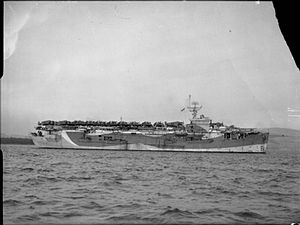HMS Ameer
 |
|
| History | |
|---|---|
|
|
|
| Name: | USS Baffins |
| Builder: | Seattle-Tacoma Shipbuilding Corporation |
| Laid down: | 18 July 1942 |
| Launched: | 18 October 1942 |
| Fate: | Transferred to Royal Navy |
|
|
|
| Name: | HMS Ameer |
| Commissioned: | 20 July 1943 |
| Decommissioned: | 20 March 1946 |
| Struck: | 1946 |
| Fate: | Sold as a merchant ship; scrapped 1969 |
| General characteristics | |
| Class and type: |
|
| Displacement: | 8,333 tons |
| Length: | 495 ft 7 in (151.05 m) |
| Beam: | 69 ft 6 in (21.18 m) |
| Draught: | 26 ft (7.9 m) |
| Propulsion: | Steam turbines, 1 shaft, 8,500 shp (6.3 MW) |
| Speed: | 17 knots (31 km/h) |
| Complement: | 890 officers and enlisted |
| Armament: | 2 × 4"/50, 5"/38 or 5"/51 guns |
| Aircraft carried: | 24 |
| Service record | |
| Part of: | Eastern Fleet |
| Operations: | |
The escort carrier USS Baffins (CVE-35) (originally AVG-35, then later ACV-35) was launched 18 October 1942 by Seattle-Tacoma Shipbuilding, Tacoma, Washington; sponsored by Mrs. Laurence Bennett, wife of Commander Bennett; and commissioned 28 June 1943, Captain W. L. Rees in command. She was named after Baffin Bay in southern Texas.
These ships were all larger and had a greater aircraft capacity than all the preceding American built escort carriers. They were also all laid down as escort carriers and not converted merchant ships. All the ships had a complement of 646 men and an overall length of 492 feet 3 inches (150.0 m), a beam of 69 feet 6 inches (21.2 m) and a draught of 25 ft 6 in (7.8 m). Propulsion was provided by a steam turbine, two boilers connected to one shaft giving 9,350 brake horsepower (SHP), which could propel the ship at 16.5 knots (30.6 km/h; 19.0 mph).
Aircraft facilities were a small combined bridge–flight control on the starboard side, two aircraft lifts 43 feet (13.1 m) by 34 feet (10.4 m), one aircraft catapult and nine arrestor wires. Aircraft could be housed in the 260 feet (79.2 m) by 62 feet (18.9 m) hangar below the flight deck. Armament comprised: two 4"/50, 5"/38 or 5"/51 Dual Purpose guns in single mounts, sixteen 40 mm Bofors anti-aircraft guns in twin mounts and twenty 20 mm Oerlikon anti-aircraft cannons in single mounts. They had a maximum aircraft capacity of twenty-four aircraft which could be a mixture of Grumman Martlet, Vought Corsair or Hawker Sea Hurricane fighter aircraft and Fairey Swordfish or Grumman Avenger anti-submarine aircraft.
...
Wikipedia
